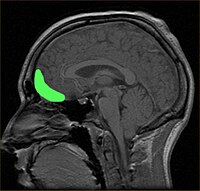
Photo from wikipedia
Background Work in humans has shown that impulsivity can be advantageous in certain settings. However, evidence for so-called functional impulsivity is lacking in experimental animals. Aims This study investigated the… Click to show full abstract
Background Work in humans has shown that impulsivity can be advantageous in certain settings. However, evidence for so-called functional impulsivity is lacking in experimental animals. Aims This study investigated the contexts in which high impulsive (HI) rats show an advantage in performance compared with mid- (MI) and low impulsive (LI) rats. We also assessed the effects of dopaminergic and noradrenergic agents to investigate underlying neurotransmitter mechanisms. Methods We tested rats on a variable inter-trial interval (ITI) version of the 5-choice serial reaction time task (5CSRTT). Rats received systemic injections of methylphenidate (MPH, 1 mg/kg and 3 mg/kg), atomoxetine (ATO, 0.3 mg/kg and 1 mg/kg), amphetamine (AMPH, 0.2 mg/kg), the alpha-2a adrenoceptor antagonist atipamezole (ATI, 0.3 mg/kg) and the alpha-1 adrenoceptor agonist phenylephrine (PHEN, 1 mg/kg) prior to behavioural testing. Results Unlike LI rats, HI rats exhibited superior performance, earning more reinforcers, on short ITI trials, when the task required rapid responding. MPH, AMPH and ATI improved performance on short ITI trials and increased impulsivity in long ITI trials, recapitulating the behavioural profile of HI. In contrast, ATO and PHEN impaired performance on short ITI trials and decreased impulsivity, thus mimicking the behavioural profile of LI rats. The effects of ATO were greater on MI rats and LI rats. Conclusions These findings indicate that impulsivity can be advantageous when rapid focusing and actions are required, an effect that may depend on increased dopamine neurotransmission. Conversely, activation of the noradrenergic system, with ATO and PHEN, led to a general inhibition of responding. Supplementary Information The online version contains supplementary material available at 10.1007/s00213-021-05883-y.
Journal Title: Psychopharmacology
Year Published: 2021
Link to full text (if available)
Share on Social Media: Sign Up to like & get
recommendations!